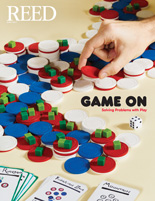
IRIS login | Reed College home Volume 96, No. 2: June 2017
<i>Shades of White:</i> Elegant, Geometrical, and Chilling

Prof. Ondrizek's "Shades of White" is a sobering meditation on social injustice. Courtesy of Geraldine Ondrizek
Prof. Geraldine Ondrizek’s thought-provoking exhibition, Shades of White, is as beautiful to look at as it is unsettling to think about. Dramatically installed in the Artist Project Space of the Jordan Schnitzer Museum of Art (University of Oregon), the show exudes minimalist cool: 24 steel boxes suspended from the ceiling by metal wires, each box backed with silk panels in muted hues. With its armada of suave, industrial rectangles seemingly floating midair, it looks like a long-lost Donald Judd installation that somehow wound up in a zero gravity chamber. But there is far more at play here than elegant geometry for its own sake; Prof. Ondrizek has created a sobering meditation on a social injustice perpetrated not only in Nazi Germany, but also in the United States.
A professor of art at Reed since 1994 and one of this year’s three Hallie Ford fellows, Ondrizek based her exhibition around the specter of eugenics, a pseudoscience that posited that Caucasians were genetically superior to other races. Eugenics was used to rationalize genocide during the reign of Adolf Hitler in Germany and was also appropriated in the United States as a justification for forced abortions, sterilizations, and discriminatory adoption practices. In fact, some 60,000 state-mandated sterilizations were performed in the U.S. from the early 20th century through the ’80s, including 2,600 in Oregon. To concretize this injustice, Ondrizek fabricated a three-dimensional abstraction of a eugenics tool called the Gates Skin Color Chart. Created in 1940 by American geneticists, the chart displayed a range of hues along a spectrum, with one end labeled “Caucasian” and the other “African.” The artist hand-dyed the silk panels for each of the suspended boxes, assigning each panel a color from the Gates Skin Color Chart. As viewers walk among the hanging boxes, they are forced to confront the legacy of eugenics—not as a historical abstraction, but as a set of physical objects.
Ondrizek has been addressing themes related to biology and medical ethics for two decades now. Of Czech-German heritage, she grew up surrounded by family members who had survived the Holocaust, so she has a deeply personal connection to the ideas she explores in her artwork. For Shades of White, she felt it important for the materials she used to reflect the melting pot of cultural identity. The silk inside the metal boxes is from China, Uzbekistan, and India, and was dyed with pigments from Brazil, India, Mexico, and the Caribbean. These media and their origins evoke the long and violent history of the Silk Road, storied avenue of commerce, colonialism, and cultural exploitation. Equally symbolic is the artist’s use of steel, an alloy closely linked to industrialism and expansionist capitalism; not incidentally, it is also used to forge prison bars.
For all its visual panache, this is an exhibition with sinister overtones. The hanging boxes evoke the bodies hanging from wires on the well-known book cover of Robin Cook’s 1977 novel Coma. Gray and implacable, Ondrizek’s metal planes hold forth with silent stories of children never conceived or never born due to forced sterilizations and abortions. Like souls suspended in Purgatory, the rectangles hang like empty cribs, morgue cabinets, or tombstones in a floating mausoleum. Arriving on the heels of the Jordan Schnitzer Museum’s Kara Walker exhibition, which explored race and racism, and running concurrently with Ryo Toyonaga’s Awakening, with its bizarre, sexualized imagery, Ondrizek’s Shades of White is the latest in a string of exhibitions that have demonstrated just how committed the museum is to exploring challenging subject matter. Forcefully curated by June Black and Jessi DiTillio, the installation pulls viewers in with seductive shapes and hues, then, through hushed visual poetry, illuminates a chilling chapter in our collective history.
Richard Speer is a contributing critic for ARTnews, Art, Ltd., and Visual Art Source. Since 2002 he has been visual arts critic at Willamette Week. His reviews and essays have also appeared in the Chicago Tribune, the Los Angeles Times, the New York Post, Salon, Newsweek, and Opera News.
GO FURTHER:
June Black, associate curator for the Jordan Schnitzer Museum of Art, gives viewers a look at the exhibition during an episode of Oregon Public Broadcasting's Art Beat.


LATEST COMMENTS
steve-jobs-1976 I knew Steve Jobs when he was on the second floor of Quincy. (Fall...
Utnapishtim - 2 weeks ago
Prof. Mason Drukman [political science 1964–70] This is gold, pure gold. God bless, Prof. Drukman.
puredog - 1 month ago
virginia-davis-1965 Such a good friend & compatriot in the day of Satyricon...
czarchasm - 4 months ago
John Peara Baba 1990 John died of a broken heart from losing his mom and then his...
kodachrome - 7 months ago
Carol Sawyer 1962 Who wrote this obit? I'm writing something about Carol Sawyer...
MsLaurie Pepper - 8 months ago
William W. Wissman MAT 1969 ...and THREE sisters. Sabra, the oldest, Mary, the middle, and...
riclf - 10 months ago